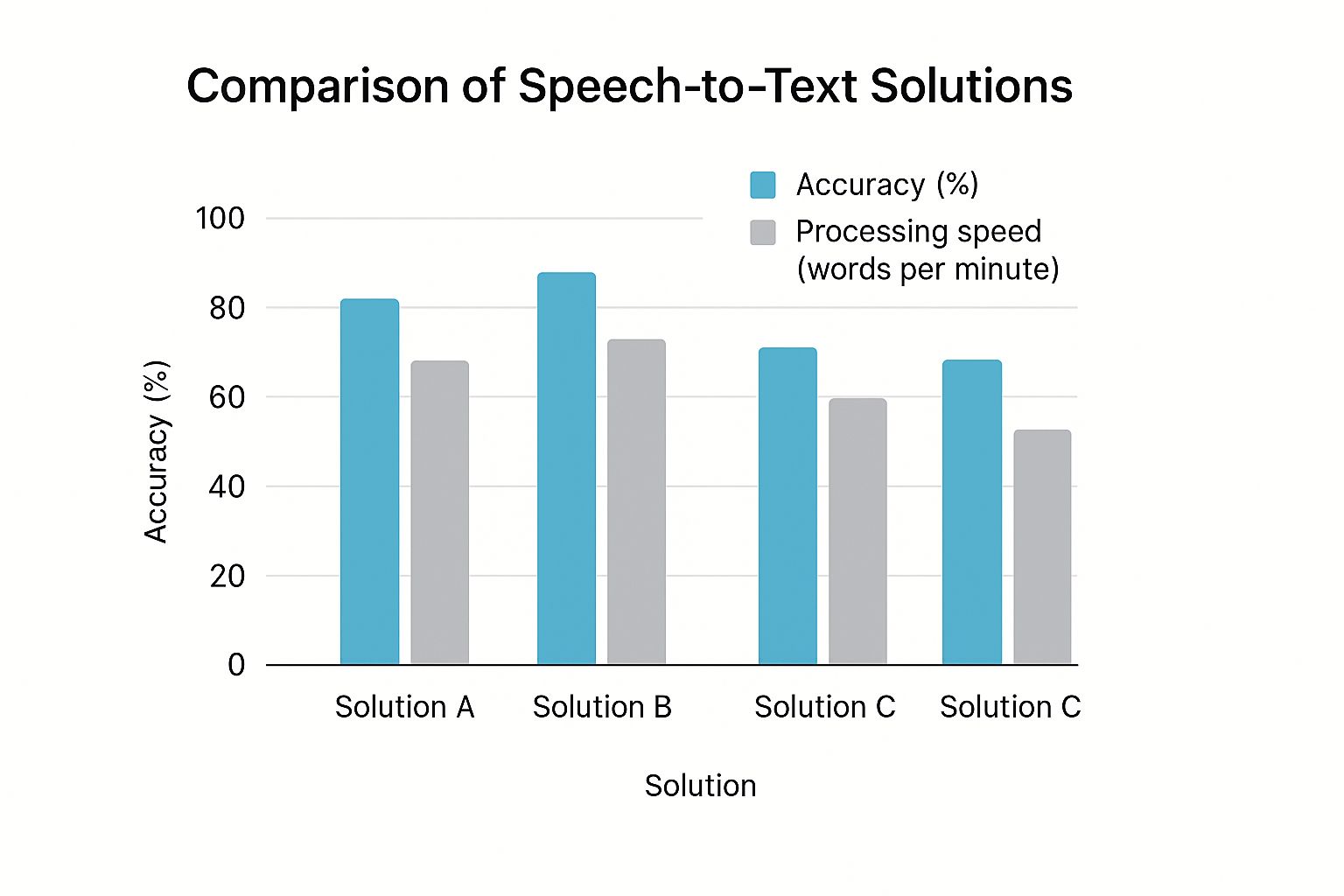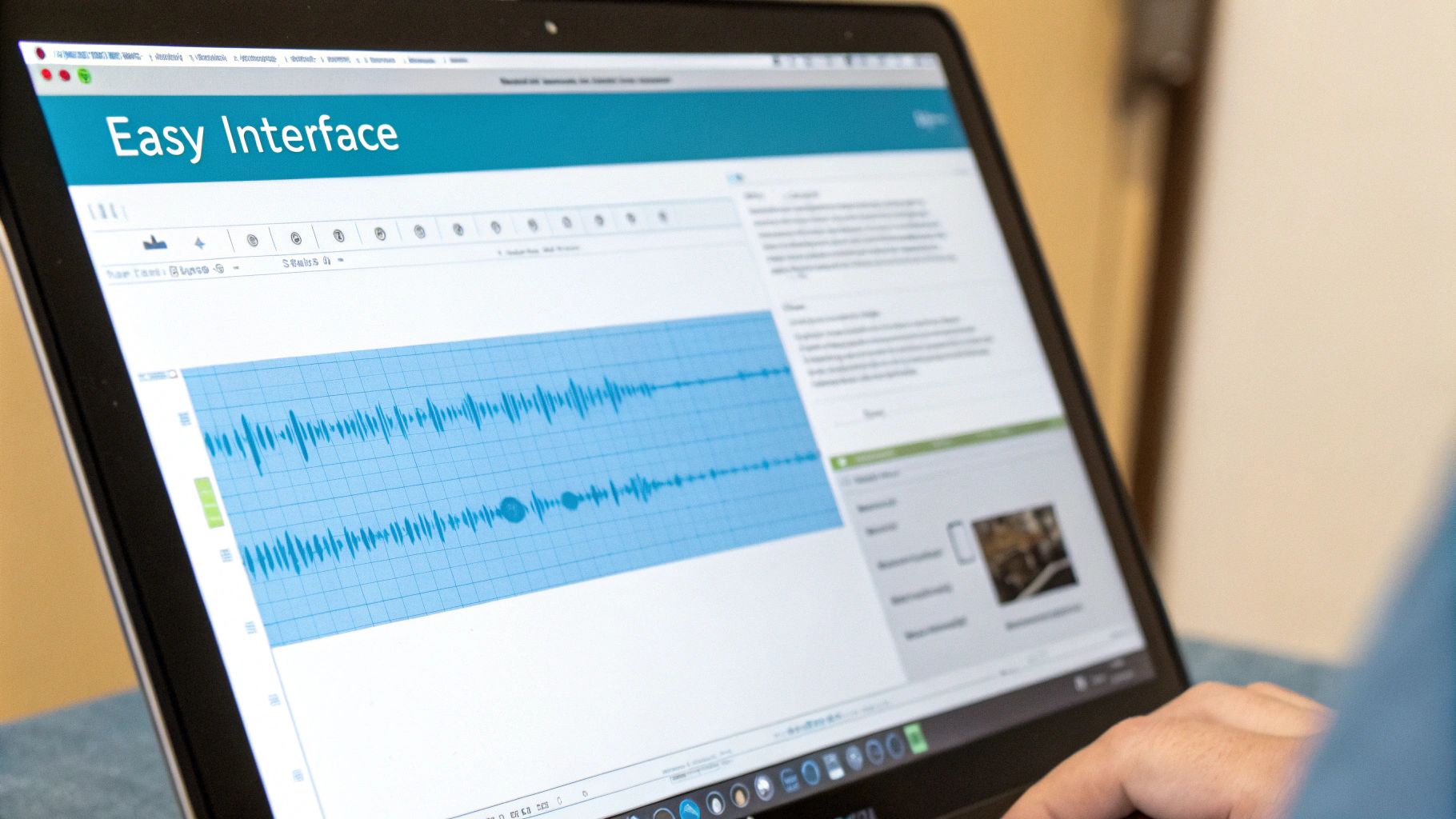Do you want your computer to type what you say? Picking the right tool is like picking the right crayon for a picture. It all depends on what you want to draw. For simple, free talking-to-text, Google Docs Voice Typing is easy. But if you need it to be super right and learn special words, a tool like WriteVoice is a great mix of smart and safe.
What Is Speech To Text Software?
Imagine a magic helper who types everything you say. That’s what speech to text software is. It's a helper on your computer or phone. It listens to your voice and turns your words into text on the screen.
This is a big help for many people. If you have a great idea but can't type fast, you can just talk. The software will write it down for you. It's a much faster way to save your thoughts.
Here is how different people use it:
- Kids in School: They can record what a teacher says. Later, they get a paper with all the words. This helps them listen and learn in class instead of just writing.
- Doctors and Cops: Busy people can talk about their work on the go. This saves them a lot of time from having to type everything out later.
- Writers and Dreamers: They can talk about a story or an idea while on a walk. This turns fun ideas into words without being stuck at a desk.
How These Tools Work
How does it turn your voice into words? It’s pretty smart. The software listens to the sounds you make. It cuts the sounds into tiny pieces. Then, it uses smart computer brains to guess what words you said. It gets better and better at this all the time. It can even understand you if you talk with a different sound or if it’s noisy.
This picture shows the simple steps a computer takes to hear you and write your words.


As you can see, it cleans up the sound, looks at the sound shapes, and then guesses the right words.
The real magic is that the software learns. The more you use it, the better it knows your voice and the words you use. This means it makes fewer mistakes over time.
This learning power is why so many people are using it. The world of talking helpers was worth USD 8.49 billion in 2024. It is set to get much bigger, reaching USD 23.11 billion by 2030. This is because of things like smart speakers in our homes and voice controls in our cars. You can explore more about this growing market and see how it all works.
A Look at the Top Talking-to-Text Tools
Picking the right speech to text tool isn't easy. It’s like picking the right person for a big job. Let’s look at the big names: WriteVoice, Google Speech-to-Text, and Dragon. Each one is good at something different. We will check them out to see which one is best for you.
We'll look at what really matters. How well do they hear you? Are they easy to use? What special things can they do? This review will help you pick the right one.
How Well Do They Understand You?
The most important job for these tools is to get your words right. We call this accuracy. If a tool gets it wrong, you spend more time fixing it than you saved.
Dragon has been a top tool for years. Its best trick is learning your voice. If you are a doctor who says words like "femur," you can teach Dragon those words. Then, it can be right almost every time, like 99% of the time.
Google Speech-to-Text uses Google’s giant computer brain. This makes it very good at understanding all kinds of voices and ways of talking without any training.
WriteVoice is also right more than 99% of the time for most people. Its cool thing is that it learns on its own. When you fix a word, it remembers. It gets better and better at knowing how you talk.
This chart shows you how good they are at getting words right and how fast they are.


As you can see, all three are very good. The small changes in speed might help you pick one.
How Simple Are They To Use?
A super smart tool that is hard to use is no good. You need one that is easy and doesn't get in your way. Being simple is a big deal.
Google Speech-to-Text is maybe the easiest. If you use Google Docs, you just click a button and talk. You don't have to put anything on your computer, and it’s super easy to learn.
WriteVoice is also made to be simple. The big difference is that it works everywhere on your computer. You can talk into an email, a chat box, or any place you can type. It feels very natural.
Dragon is the strongest, but also the trickiest. It has lots of buttons and choices. This is great for people who want to control everything. But it can feel like a lot for someone new.
What Special Tricks Can They Do?
These tools do more than just write what you say. They have cool tricks to help you do more. This is a big business—worth about USD 10.46 billion in 2018, and it’s expected to be USD 31.8 billion by 2025. This is because computers are getting smarter.
Here are some of their best tricks:
- Special Words: Both Dragon and WriteVoice let you make your own word list. This is a big help for people who use special words for work that normal tools don't know.
- Voice Commands: Dragon is amazing at this. You can tell your computer what to do. You can say "Open my email" or "Go down," and it will do it.
- Keeps Secrets: For people with secret work, WriteVoice is a great choice. It does its work right on your computer. It does not save your voice or words. This is very important if you have to keep things private.
The best tool is not always the one with the most tricks. It's the one that fits into your day so well that you don't even notice you're using it.
To help you see how they are different, here is a chart that shows what each tool can do.
Speech To Text Software Feature Comparison
This table shows WriteVoice, Google, and Dragon side-by-side. It points out what makes each one special.
| Feature | WriteVoice | Google Speech-to-Text | Dragon NaturallySpeaking |
|---|---|---|---|
| Best For | People who need privacy & right words | People who use it for fun & in Google | People who want to control their PC with their voice |
| Special Words | Yes, learns from you | A little | Yes, you can add lots of words |
| Works Everywhere | Yes, in any program | Mostly in Google apps | Yes, full computer control |
| Privacy | High (saves no data) | Normal (uses data to get better) | High (can work on your computer only) |
| How Hard to Set Up | Easy | Very Easy | Hard |
In the end, the best one for you is the one that fits how you work.
Of course, cost matters too. Some tools are free, and some you pay for. To see how companies sell their tools, you can look at theclipbot's pricing plans. Seeing what others offer helps you know if a tool is a good deal.
How We Put These Tools to the Test
To find the best speech to text software, we had to try them in the real world. A tool that only works in a quiet room is not very helpful. Life is loud and messy, and our tests had to be too.
We had a simple but smart plan. We treated each tool like it was taking a test in school. We read the same short story to each tool. But we changed where we were each time. This made it easy to see which tool was a great student and which one got mixed up by noise.
The goal was easy: count the mistakes. Fewer mistakes mean the tool is better. This simple score gives you a clear idea of which tool did the best in each test.
The Quiet Room Test
First, we gave the tools an easy test. We sat in a very quiet room, closed the door, and read our story in a clear voice. This showed us how well each tool works when everything is perfect.
This was the easy part of the test. As we thought, the best tools like WriteVoice and the others did great. It showed that when it's quiet, these tools are very good.
Adding Some Real-World Noise
Next, we made things harder. We took our laptops to a busy coffee shop. We read the same story again with people talking, dishes clanking, and workers calling out orders. This test shows which tools are good and which are great.
Here, some tools had problems. They mixed up our words with what other people were saying. The really great tools were able to block out the noise and just listen to our voice. Being able to work in noisy places is a big part of what speech to text accuracy really means.
A great speech-to-text tool doesn't just hear words. It understands what's going on. This helps it ignore noise and listen only to you. This is a big plus in real places like an office or a cafe.
Different Voices, Different Speeds
People don't talk like robots. We talk fast when we're excited and slow when we're tired. So, we tested that too.
- Fast Talking: We read the story very fast, like someone in a hurry.
- Slow Talking: Then, we read it very slowly, saying each word with care.
Some tools messed up when we talked fast. They missed words or guessed the wrong ones. The best tools kept up no matter how fast or slow we talked. This is very important if you talk out your ideas as they pop into your head.
Last, we had friends with different ways of talking read the story. A tool that only knows one way of talking is not good for a team with people from all over. The software that could understand everyone was the real winner.
More and more people need tools that can handle these real-world tests. The world market for these tools was about USD 3.81 billion in 2024. It's set to grow to USD 8.57 billion by 2030. This big growth shows how many people are starting to use this tech. You can discover more about the growing speech-to-text market to see why it's so important for these tools to work well in real life.
By testing the tools this way, we found the ones that are truly the best at getting words right.
How Talking-to-Text Software Helps in Real Life
Lists of what a tool can do are nice. But what really matters is how it helps you with a real problem. A tool is only good if it makes your life easier. Let’s look at a few stories of how this software helps real people do more.
These stories show that this is not just about cool tech. It's about getting your time back and making your work easier in ways that matter.


For The News Writer on a Deadline
Meet Javier. He is a news writer who is always busy. His days are full of talks, phone calls, and looking for stories. For a long time, the worst part of his job was typing up his recorded talks. It was slow, boring work that took away from his writing time.
Javier started using WriteVoice on his phone. Now, when a talk is over, the app has already turned the whole chat into text. He can quickly find the important parts and start writing his story. This saves him over 90% of his old typing time. It is so good that he only spends a few minutes fixing names or special words.
What really changed for Javier was not just the time he saved. It was that he could start writing right away. Before, he had to wait hours. Now, he can write his story when the ideas are still new in his head.
For anyone who does interviews for work, a good https://www.writevoice.io/blog/voice-recorder-with-transcription-app/ is a must-have. It turns a sound file into a paper you can use right away.
For The Student in a Big Class
Now, think about Chloe, a college student with many hard classes. Her biggest problem was trying to listen to her teacher, understand big ideas, and write good notes all at the same time. She always felt like she was missing important things because she was too busy writing.
Chloe learned she could use Google's free tool to record her online classes. She just turns it on when class starts. It makes a list of everything the teacher says. This small change made a huge difference for her.
Now she can:
- Pay full attention to the teacher and what’s on the screen.
- Talk in class without worrying about falling behind on notes.
- Quickly look for words in the text when she studies for a test.
This helps her be more a part of the class and learn more. The software does the hard work of taking notes so she can do the real work of learning.
For The Busy Animal Doctor
Last, there’s Dr. Anya, an animal doctor with a full waiting room. After seeing each pet, she has to write down everything about the visit. Typing these notes used to take up a big part of her day. This meant she could not see as many furry friends.
Dr. Anya now talks her notes using a special tool like Dragon. As she goes from room to room, she just says what she saw into a microphone. The software knows her special animal doctor words. It quickly puts correct, full notes into the office's computer system.
This has totally changed her workday. She finishes her notes much faster. This gives her more time to see pets and makes less work for her helpers.
And it’s not just for these jobs. For people who make videos, this software can help make videos that more people can enjoy. For example, it can help with adding subtitles on TikTok. From news writers to doctors, these tools help fix real-world problems.
Your Voice Words: Where Do They Go?
When you talk to your computer, do you ever wonder where your words go? It’s a very important question. How a tool takes care of your voice words should be a big part of any speech to text software review.
Some tools are like a private diary. They listen to your voice and turn it to text right on your own computer. Your words never leave your machine. This keeps them totally secret.
Other tools are more like sending a letter. A recording of your voice is sent over the internet to a big, powerful computer far away. That computer is great at writing down your words. But it means your private words are on someone else’s computer.
On Your Computer vs. In the Cloud
The big difference is on-device versus cloud. Think of it like cooking. On-device is like making food in your own kitchen. Only you see what goes into it. The cloud is like ordering food. You get the final dish, but someone else made it in their kitchen.
Let’s see how our top tools handle your words:
WriteVoice: This tool is built to keep your words safe. It does everything right on your computer. Nothing is sent to the cloud. No voice or text is ever saved. This makes it a very safe choice for doctors, lawyers, or anyone with secret ideas.
Dragon: Dragon has been a name people trust for a long time. It also has strong choices to work right on your computer. This keeps your private talks local. You are in full control of your words.
Google Speech-to-Text: Google's tool uses the cloud. It sends your voice words to Google's big computers to be very accurate. Google is very safe, but your words are used to make their tools better. This might not be okay if you have very secret things to say.
Why Keeping Words Private Is a Big Deal
Imagine you are a doctor talking about a patient, a writer with a secret story idea, or a boss talking about a secret deal. You would not want that saved on a computer you don't own. If that computer got hacked, your secrets could get out.
Choosing a tool that keeps your words private is not just about feeling safe. It's about protecting important things. For many jobs, keeping words secret is the law, not just a choice.
Knowing your words are safe is just as important as getting them written down right.
Making the Right Choice for You
So, which should you pick? It all comes down to what kind of work you do.
If you are just making a food list or a quick note to a friend, a cloud tool like Google is fine. It is easy to use for simple things.
But, if you are working with any words that must stay private, a tool that works on your computer is the only good choice. For people who need the very best safety, a tool like WriteVoice is made to make sure your words are yours and yours alone.
So, Which Speech-to-Text Tool Should You Choose?
Picking the right talking-to-text software is all about what you need to do. There is no single "best" tool for all people. The best choice is the one that fits your needs. Let's look at who gets the most from different kinds of tools.
For students or anyone who needs to turn talk into text now and then, a simple and free tool is often best. Think about turning a class talk into notes for a test or saving a quick idea. Something like Google's free speech-to-text tool works well. It costs nothing and is easy to use.
For Pro Workers and People Who Create Things
Now, let's talk about harder jobs. If you are a doctor, a lawyer, or a teacher, you use special words. Normal tools will get these words wrong. This is where a strong program like Dragon is great. You can teach it your special words so it gets them right more often.
But what if you are a writer, a podcaster, a business owner, or a video maker? You need something a little different. You want a tool that gets words right, is easy to use, and keeps your work private.
That’s exactly why we built WriteVoice. It was made to be the perfect mix for creators and pro workers who need a good tool that keeps their work secret and makes their day easier.
If you just need to turn a single recording into text, you can learn how to convert audio to text online for free with our guide. The right software is out there. It's ready to help you save time and turn your spoken ideas into clear, written words.
Questions People Ask About Speech-to-Text
Thinking about which speech-to-text tool is right for you? Let's answer a few common questions I get all the time.
Do These Tools Work Without the Internet?
Some do, but many don't. And that makes a big difference.
It depends on where the work happens. Cloud tools, like Google's, need the internet. They send your voice to a faraway computer to get turned into text. This means you can't use it on a plane or if your internet stops working.
On the other hand, tools like WriteVoice are made to work offline. All the work happens right on your computer. This is great for keeping your words private since they never leave your machine. It also means you can write with your voice anywhere, any time.
Can They Understand Different Languages?
Yes. Most new talking-to-text software can speak many languages. You just have to tell the tool what language you are speaking, and it will switch.
The best tools are very smart and can often work with dozens of languages. This is a big help for teams from around the world or for people making things in many languages.
What About Different Accents?
This is where the great software shows how good it is. The best tools are taught with many different kinds of voices. This means they can usually understand how you talk right away.
Also, many tools learn your special voice over time. The more you use it, the better it gets at knowing how you talk. This means it makes fewer mistakes.
When I check out speech-to-text software, one of the main things I test is how it handles accents. The best tools don't just have one way of listening. They learn from you and get better and better.
Is There a Real Difference Between Free and Paid Tools?
Yes, and it’s a very big difference, especially if you use it for work. Free tools are fine for a quick text or a short note, but they can't do much more.
Paid tools are where you get real power. They are much better at getting your words right. They also have cool tricks like letting you add your own special words. This means the software will always get your work words or company names right. And very important, paid tools almost always keep your words more private. This is a must for secret business or client work.
Ready to stop typing and start talking? WriteVoice offers the perfect mix of accuracy, privacy, and ease of use. Try WriteVoice today and see how much time you can save.
